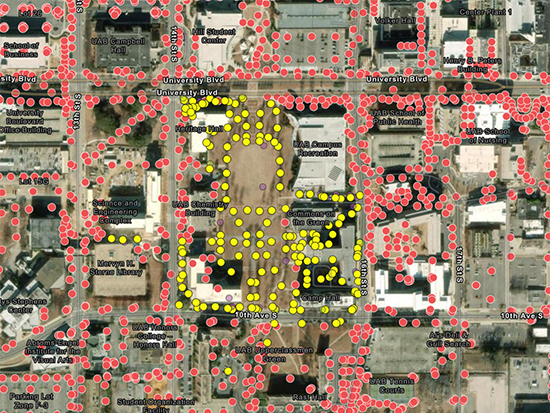 The University of Alabama at Birmingham is addressing light pollution with new Campus SHINE at UAB program.The University of Alabama at Birmingham is addressing light pollution via the Campus Safe and Healthy Illumination for the Nighttime Environment at UAB.
The University of Alabama at Birmingham is addressing light pollution with new Campus SHINE at UAB program.The University of Alabama at Birmingham is addressing light pollution via the Campus Safe and Healthy Illumination for the Nighttime Environment at UAB.
Light pollution is the poor management and distribution of artificial lighting released into the natural environment.
Michelle Wooten, Ph.D., assistant professor of astronomy in the Department of Physics, is the lab director for Campus SHINE at UAB.
Wooten says this project illuminates the necessity for targeted lighting that promotes the overall safety and wellness of UAB students and campus environment preservation. Proper lighting practices improve the visibility of one’s surroundings by reducing glare. Well-designed lighting can save the campus money through eliminating energy expenditure in unnecessary directions, supporting visibility of the stars, and protecting human and environmental health.
“Untargeted lighting can negatively affect our well-being and our natural environment,” Wooten said. “Excessive lighting at night can disrupt melatonin production and throw off our circadian rhythm.”
In addition to having negative effects on on-campus students, light pollution can largely impact the natural wildlife and environment. Light pollution can impact the ecosystem, for example via the disruption of biological processes in plants and pollinators. Excessive untargeted lighting is also a global factor in climate change, through unnecessary fossil fuel burning and release of greenhouse gas emissions.
In preservation of the nighttime sky, the American Astronomical Society formed the Committee for the Protection of Astronomy and the Space Environment, or COMPASSE. Wooten, a member of the AAS who serves on this committee, brought the Campus SHINE subcommittee efforts of COMPASSE to UAB.
 Wooten and her team took data on each light on the campus green, highlighted in yellow. Wooten launched Campus SHINE at UAB this summer. In collaboration with UAB Facilities, Wooten and her student assistants have been working to assess the current state of on-campus lighting.
Wooten and her team took data on each light on the campus green, highlighted in yellow. Wooten launched Campus SHINE at UAB this summer. In collaboration with UAB Facilities, Wooten and her student assistants have been working to assess the current state of on-campus lighting.
The Campus SHINE at UAB team first geolocated the lights on the campus green. Wooten and her team took data on each light, documenting whether it was shielded, analyzing whether the phosphorus coating was fully intact and measuring the correlated color temperature.
“Targeted lighting is arguably the most important element in proper lighting techniques, so you want outdoor lighting to be shielded,” Wooten said. “You also want to make sure to use ‘warmer’ or redder-appearing colors, so we want nighttime lighting to reduce and preferably eliminate blue wavelength emissions.”
Correlated color temperature is measured in the Kelvin unit. Lights that peak in longer wavelengths appear softer or amber-toned and emit under 3,000 K, which are dark-sky-friendly temperature readings. White or bluer-appearing lights emit primarily at a higher temperature. Readings over 3,000 K to around 7,000 K, bluer-appearing lights have a greater negative impact on human and environmental health. Bluer light scatters farther into the atmosphere.
Students interested in participating in projects related to Campus SHINE may consider enrolling in the course AST 121: Starry Skies in Birmingham, a City as Classroom, offered in fall 2024.
Brian Templeton, director of Planning, Design and Construction for UAB Facilities, says the work of Campus SHINE and Wooten is greatly improving their ability to accurately inventory the diverse population of over 3,800 lights around UAB’s campus.
“The data they are collecting allows us to better manage the efficacy and efficiency of our campus lighting, including reducing light pollution and improving compliance with DarkSky initiatives,” Templeton said.
The recommendations made by Wooten and her team will be incorporated into the campus master plan in 2025.